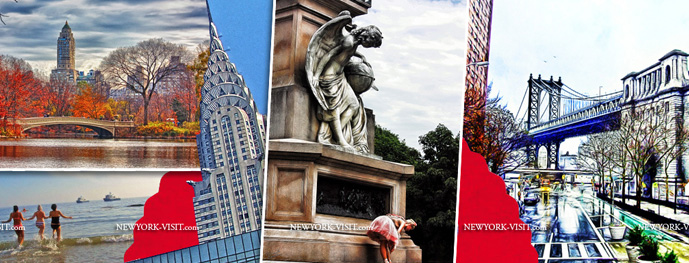Brooklyn Bridge New York City
Bridges – Must See Tourist Attractions in New York City
Bridges & Tunnels in NYC, New York, USA
Home » Travel Arrangements » Sightseeing » Bridges » Brooklyn Bridge »info
Brooklyn Bridge
The Brooklyn Bridge, one of the oldest suspension bridges in the United States, stretches 5,989 feet (1825 m) over the East River connecting the New York City boroughs of Manhattan and Brooklyn. On completion, it was the largest suspension bridge in the world and the first steel-wire suspension bridge. Since its opening, it has become an iconic part of the New York Skyline.

History
Construction began January 3, 1870. The Brooklyn Bridge was completed thirteen years later and was opened for use on May 24, 1883. On that first day, a total of 1,800 vehicles and 150,300 people crossed. The bridge’s main span over the East River is 1,595 feet 6 inches (486.3 m). The bridge cost $15.5 million to build and approximately 27 people died during its construction.
One week after the opening, on May 30, a rumor that the Bridge was going to collapse caused a stampede which crushed and killed twelve people.
At the time it opened, it was the longest suspension bridge in the world – 50% longer than any previously built – and it has become a treasured landmark. Additionally, for several years the towers were the tallest structures in the Western Hemisphere. Since the 1980s, it has been floodlit at night to highlight its architectural features. The towers are built of limestone, granite, and Rosendale cement. Their architectural style is Gothic, with characteristic pointed arches above the passageways through the stone towers.
The bridge was designed by German-born John Augustus Roebling in Trenton, New Jersey. Roebling had earlier designed and constructed other suspension bridges, such as Roebling’s Delaware Aqueduct in Lackawaxen, Pennsylvania, the John A. Roebling Suspension Bridge in Cincinnati, Ohio and the Waco Suspension Bridge in Waco, Texas, that served as the engineering prototypes for the final design.
During surveying for the East River Bridge project, Roebling’s foot was badly injured by a ferry, pinning it against a pylon; within a few weeks, he died of tetanus. His son, Washington, succeeded him, but in 1872 was stricken with caisson disease (decompression sickness, commonly known as “the bends”), due to working in compressed air in caissons. The occurrence of the disease in the caisson workers caused him to halt construction of the Manhattan side of the tower 30 feet (10 m) short of bedrock when soil tests underneath the caisson found bedrock to be even deeper than expected. Today, the Manhattan tower rests only on sand. Washington’s wife, Emily Warren Roebling, became his aide, learning engineering and communicating his wishes to the on-site assistants. When the bridge opened, she was the first person to cross it. Washington Roebling rarely visited the site again.
At the time the bridge was built, the aerodynamics of bridge building had not been worked out. Bridges were not tested in wind tunnels until the 1950s – well after the collapse of the Tacoma Narrows Bridge in 1940. It is therefore fortunate that the open truss structure supporting the deck is by its nature less subject to aerodynamic problems. Roebling designed a bridge and truss system that was six times as strong as he thought it needed to be. Because of this, the Brooklyn Bridge is still standing when many of the bridges built around the same time have vanished into history and been replaced. This is also in spite of the substitution of inferior quality wire in the cabling supplied by the contractor J. Lloyd Haigh – by the time it was discovered, it was too late to replace the cabling that had already been constructed. Roebling determined that the poorer wire would leave the bridge four rather than six times as strong as necessary, so it was eventually allowed to stand, with the addition of 250 cables. Diagonal cables were installed from the towers to the deck, intended to stiffen the bridge. They turned out to be unnecessary, but were kept for their distinctive beauty.
After the collapse of the I-35W highway bridge in the city of Minneapolis, increased public attention has been brought to bear on the condition of bridges across the US, and it has been reported that the some of the Brooklyn Bridge approach ramps received a rating of “poor” at its last inspection. According to a NYC Department of Transportation spokesman, “The poor rating it received does not mean it is unsafe. Poor means there are some components that have to be rehabilitated.” A $725 million project to replace the approaches and repaint the bridge is scheduled to begin in 2009.

Brooklyn Bridge 125th Anniversary
Brooklyn Bridge’s 125 anniversary was celebrated in May 2008 with fireworks, a Navy flyover, a colourful new lighting scheme, a musical tribute to honour the storied span, and even a birthday cake in the shape of the bridge.
Brooklyn Bridge 125th Anniversary Concert | Brooklyn Bridge 125th Birthday | The New York City Waterfalls
Access Point
The Brooklyn Bridge is accessible from the Brooklyn entrances of Tillary/Adams Streets, Sands/Pearl Streets, and Exit 28B of the eastbound Brooklyn-Queens Expressway. In Manhattan, the bridge can be entered from either direction of the FDR Drive, Park Row, Chambers/Centre Streets, and Pearl/Frankfort Streets. Pedestrian access to the bridge from the Brooklyn side is from either Tillary/Adams Streets (in between the auto entrance/exit), or a staircase on Prospect Ave between Cadman Plaza East and West. In Manhattan, the pedestrian walkway is accessible from the end of Centre Street, or through the unpaid south fare zone of Brooklyn Bridge-City Hall IRT subway station.
Details
Length of river span: 1595.5 feet
Total length of bridge: 5989 feet
Wdith of bridge floor: 85 feet
Suspension cables: four, each 15.75 inches in diameter and 3578.5 feet long, containing 5434 wires each, for a total length of 3515 miles of wire per cable
Foundation depth below high water, Brooklyn: 44 feet 6 inches
Foundation depth below high water, Manhattan: 78 feet 6 inches
Tower height above high water: 276 feet 6 inches
Roadway height above high water: 119 feet (at towers)
Total weight, not including masonry: 14,680 tons







